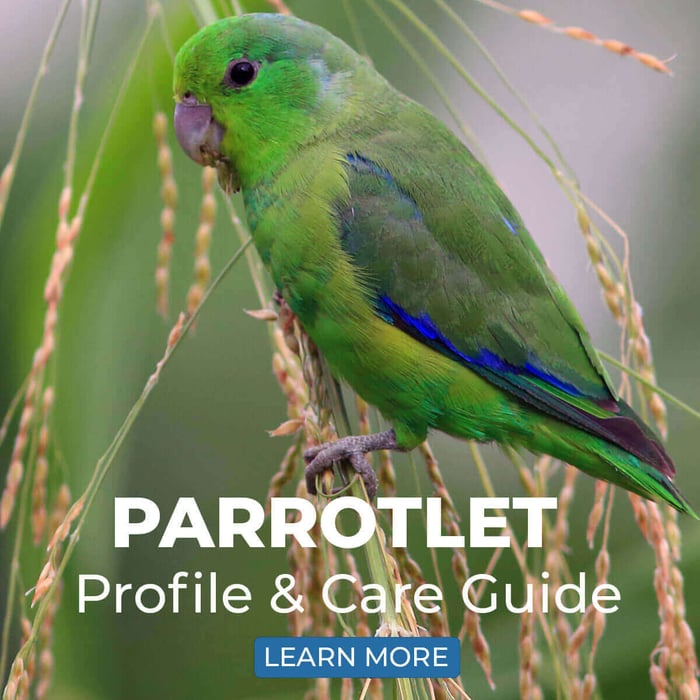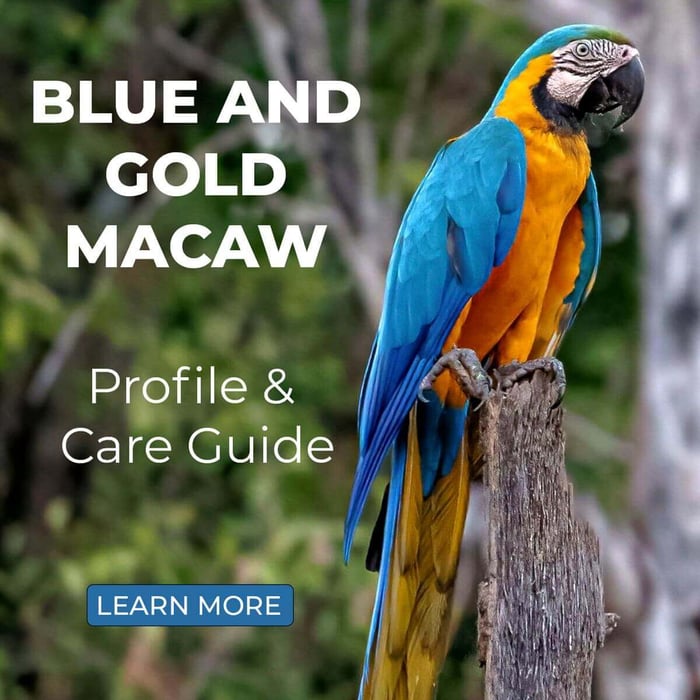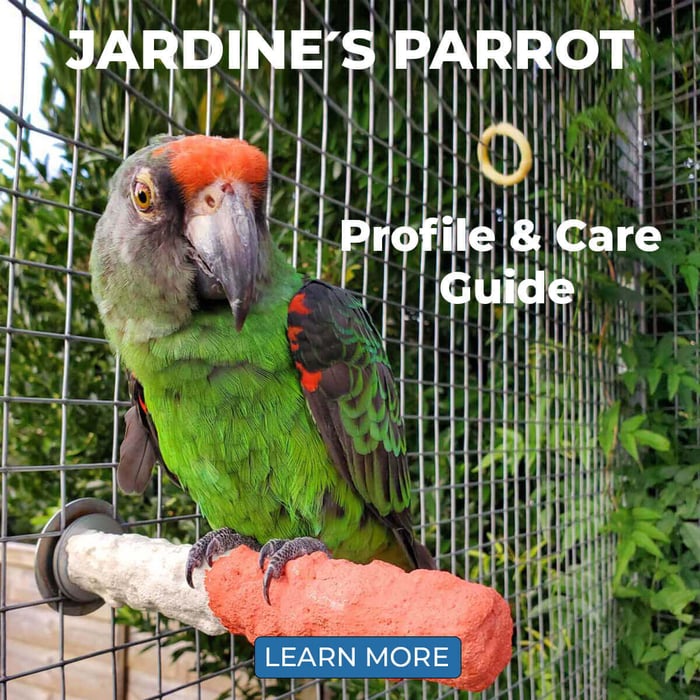Senegal Parrot – Profile & Care Guide
| Common name: | Senegal Parrot |
| Scientific name: | Poicephalus senegalus |
| Length: | 23 cm/9 inches |
| Weight: | 120-150 grams |
| Life Span: | 25-30 years |
| Origin: | Savanna woodlands and forests of West Africa (Senegal, Gambia and Mali) |
| Noise Level: | Low |
NATURAL HABITAT
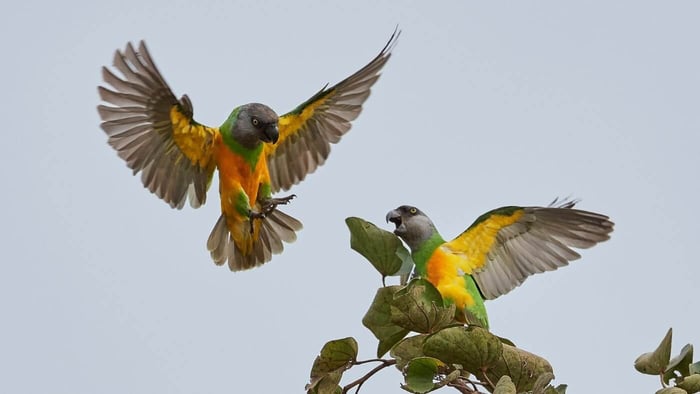
The Senegal parrot (Poicephalus senegalus) is naturally found in West Africa. It does indeed occur in Senegal, but also as far north as Mauritania, as far east as Chad, and right down to the Gulf of Guinea coast. Populations can be semi-nomadic, following their favourite foods as the seasons change.
This species is really not picky about habitat type as long as there are some trees available. It inhabits everything from dense forests to more open farmland and even marshes. It particularly favours savannahs with plenty of baobab and locust bean trees in which to nest.
The IUCN Red List considers the Senegal parrot a species of Least Concern. It is noted that the population is likely dropping and needs to be studied further, especially given that trapping of the species for the pet trade is still common.
SENEGAL PARROT INTELLIGENCE & PERSONALITY
Senegal parrots are one of our favourite choices when it comes to pet parrots, thanks to their gentle and engaging personalities. They’re known for being sweet-natured and less demanding compared to many other parrot species. Perfect if you’re looking for a sociable and affectionate bird! Additionally, they’re highly intelligent and usually eager to learn tricks or play with puzzle toys.
Like other parrot species, Senegals can form strong bonds with their owners. They need plenty of attention to prevent boredom and stress, including daily interaction in the form of training sessions, playing together, and just hanging out on your shoulder. Most will appreciate a good head-scratching session as well!
Caring for a Senegal involves a balance of engaging playtime and consistent, nurturing attention, ensuring they feel loved and part of the family. If you’re not able to spend at least a few hours a day with your parrot, it’s important to get it a friend of its own species to keep it company.
SENEGAL PARROT TALKING ABILITY
Senegals aren’t known for being the most talented talkers in the parrot world. That honour goes to species like budgies and African greys! This being said, almost all parrots can mimic sounds and speech to some degree, and some Senegal owners do report hearing their birds imitate household noises. It’s just that their voices tend to be softer and not very distinct, similar to small parakeets.
Although Senegals aren’t champion talkers, that doesn’t mean you can’t do talking training with your bird. Talking to it and letting it listen to all sorts of sounds helps keep a parrot entertained and strengthens your bond. Eventually, hearing the sounds or words repeated back to you is just a bonus!
SOUND LEVEL
One huge advantage of Senegal parrots, which often makes them a recommended choice for beginner parrot owners, is their relatively quiet nature. This makes them suitable for apartment living in most cases.
It’s important to remember that all parrots are noisy beings, and this species is no exception. However, the noise is definitely not as ear-piercing and constant as with some similarly sized parrots, such as many conures.
FEEDING & NUTRITION FOR YOUR SENEGAL PARROT
Wild Senegal parrots mainly feed on plant-based foods like seeds and grains, fruits, and leaf or flower buds. They’re particularly fond of figs and the seeds of the wild locust tree, but will also raid farmers’ fields for crops like millet and maize. Quite a variety!
It’s important to feed your pet Senegal parrot a similarly varied diet. A high-quality parrot pellet for small birds works well as a staple. Supplement with a good seed mix, as well as daily portions of fresh vegetables and regular portions of fresh fruits. You can offer foods like nuts and millet as treats.
Of course, your Senegal also requires access to clean, fresh water at all times. You should place a source of calcium, like a cuttlebone, in the cage for your bird to nibble at when it feels the need. Wash both water and food dishes daily.
HOUSING FOR YOUR SENEGAL PARROT
When selecting a cage for your Senegal parrot, it’s recommended to choose one with a minimum size of 45cm x 45cm x 60cm. If you’re planning on keeping your parrot in its cage for most of the day, you should go for at least double that. A spacious cage allows for a variety of toys and ample room for the parrot to stretch its wings and play, which is crucial for their physical and mental well-being.
The spacing between the bars of the cage is also important. They should be between 1.5cm and 2cm. This prevents any risk of the bird getting its head or other body parts stuck between the bars.
As we’ve found out, Senegal parrots are highly social, so you should place the cage in a part of the house where it can regularly interact with family members. Most parrot owners prefer the living room and avoid the kitchen due to fumes. Make sure the location isn’t overly draughty or in direct sun.
The cage itself should be equipped with a variety of colourful parrot toys for your bird to chew, preen, ring, swing, and destroy. Rotate toys regularly to keep them fresh and exciting.
To keep your parrot busy while it’s outside of its cage, which should be the case for at least a few hours a day, you can get a parrot play gym with perches and toys. You can set these on top of the cage to give the bird a place to hang out and keep itself busy playing.
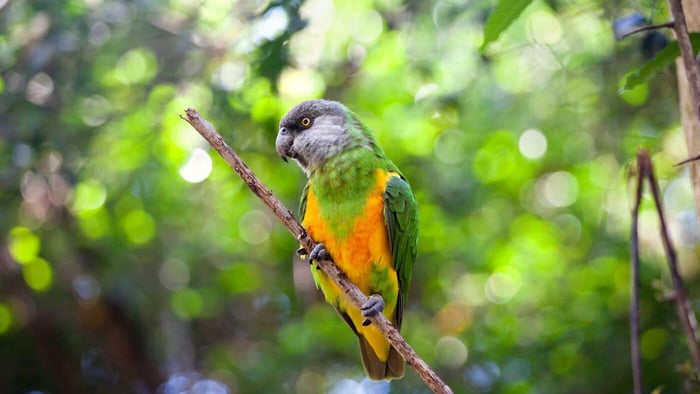
FEATHER PLUCKING & COMMON ISSUES
The Senegal generally has a reputation for being relatively resilient. It’s not overly prone to developing behaviour problems such as feather plucking, especially when compared to species like African greys. However, it’s important to note that, like most parrots, Senegal Parrots can still develop this issue if they regularly feel bored, stressed, or in pain.
Ensure your Senegal Parrot has a varied and engaging environment. This is crucial to prevent feather plucking. It also helps avoid other unwanted behaviours. These include excessive screaming and aggression. This can include providing interactive toys, foraging opportunities, and, of course, plenty of social interaction. Just keep your bird busy!
It’s also important to maintain a consistent routine for your parrot. Changes in their environment or daily schedule can lead to stress and anxiety, potentially triggering undesirable behaviours. Your bird also needs regular health check-ups, especially if its behaviour has suddenly changed.
FACTS & FAQ
- There are two subspecies of Senegals. They are Poicephalus senegalus senegalus (with a yellow belly) and Poicephalus senegalus versteri (with an orange belly).
- The genus Poicephalus contains ten species. The Senegal parrot is the most common in aviculture, but the Meyer’s parrot (Poicephalus meyeri) is also regularly kept as a pet.
- This species was first scientifically described in 1760.
- Senegal parrots are not sexually dimorphic. This means it’s almost impossible to visually tell the difference between a male and a female.
- Despite the intense look that their black heads and yellow eyes give them, a well-socialised Senegal parrot will almost always be friendly and easygoing in nature.
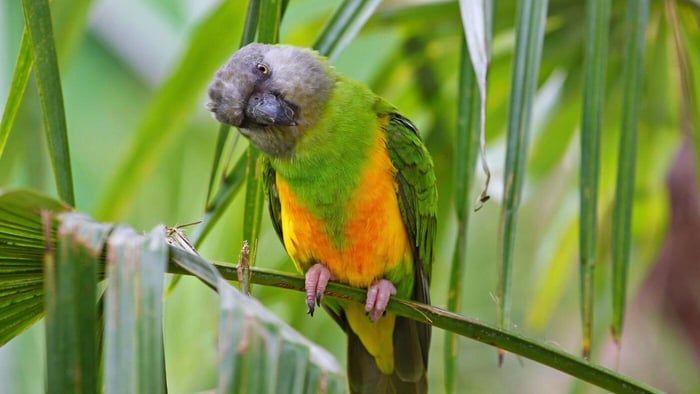
CONCLUSION
In summary, Senegal parrots are intelligent and affectionate birds. Like any parrot, they can become moody without enough attention and training. However, their temperament is usually pleasant. They’re not overly loud. They love being active, playing with their toys, and hanging out with their (human) flock.
To view other Parrot Profiles & Care Guides, visit our Alphabetical list of Parrot Fact Sheets by visiting: https://parrotessentials.co.uk/blog/parrot-profiles-care-guides
SOURCES
Parr, M., & Juniper, T. (2010). Parrots: a guide to parrots of the world. Bloomsbury Publishing.

